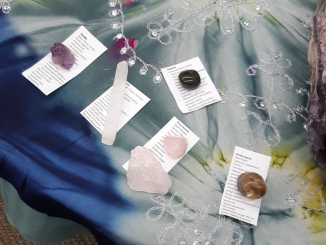
Carnelian (also spelled cornelian) is a brownish-red mineral commonly used as a semi-precious gemstone. Similar to carnelian is sard, which is generally harder and darker (the difference is not rigidly defined, and the two names are often used interchangeably). Both carnelian and sard are varieties of the silica mineral chalcedony colored by impurities of iron oxide. The color can vary greatly, ranging from pale orange to an intense almost-black coloration. It is most commonly found in Indonesia, Brazil, India, Russia (Siberia), and Germany.

History
The red variety of chalcedony has been known to be used as beads since the Early Neolithic in Bulgaria. The first faceted (with constant 16+16=32 facets on each side of the bead) carnelian beads are described from the Varna Chalcolithic necropolis (middle of the 5th millennium BC). The bow drill was used to drill holes into carnelian in Mehrgarh in the 4th-5th millennium BC. Carnelian was recovered from Bronze Age Minoan layers at Knossos on Crete in a form that demonstrated its use in decorative arts; this use dates to approximately 1800 BC. Carnelian was used widely during Roman times to make engraved gems for signet or seal rings for imprinting a seal with wax on correspondence or other important documents. Hot wax does not stick to carnelian. Sard was used for Assyrian cylinder seals, Egyptian and Phoenician scarabs, and early Greek and Etruscan gems. The Hebrew odem (also translated sardius), the first stone in the High Priest’s breastplate, was a red stone, probably sard but perhaps red jasper. In Revelation 4:3, the One seated on the heavenly throne seen in the vision of John the apostle is said to “look like jasper and ‘σαρδίῳ’ (sardius transliterated)”. And likewise it is in Revelation 21:20 as one of the precious stones in the foundations of the wall of the heavenly city.
There is a Neo-Assyrian seal made of carnelian in the Western Asiatic Seals collection of the British Museum that shows Ishtar-Gula as a star goddess. She is holding a ring of royal authority and is seated on a throne. She is shown with the spade of Marduk (his symbol), Sibbiti (שבע or sheva in Hebrew language) gods, stylus of Nabu and a worshiper. An 8th century BCE carnelian seal from the collection of the Ashmolean Museum shows Ishtar-Gula with her dog facing the spade of Marduk and his red dragon.

Carnelian Meanings and Uses
Like the unexpected fire of a sunset, or the first flash of autumn brilliance, Carnelian captivates. Its bold energy brings a rush of warmth and joy that lingers, stimulating and empowering. Known as a stone of motivation and endurance, leadership and courage, Carnelians have protected and inspired throughout history.
A glassy, translucent stone, Carnelian is an orange-colored variety of Chalcedony, a mineral of the Quartz family. Its color varies from pale pinkish-orange to a deep rusty brown, though it is most known for its brilliant orange and red-orange crystals. Its name comes from a Latin word meaning “flesh.”
In antiquity, as well as today, Carnelian is believed to help timid speakers become both eloquent and bold. Ancient Warriors wore Carnelian around their neck for courage and physical power to conquer their enemies. In Egypt it was worn by master architects to show their rank of builder, and alchemists of the Middle Ages used it as a boiling stone to activate the energy of other Chalcedonies. As the first stone in the breastplate of the High Priest, it signified the blood of the martyrs, and was once believed to prevent illness and the Plague.
The ancient Egyptians called Carnelian “the setting sun.” In its orange hues, they identified it with the receptive or passive female energies, and associated it with the fertile menstrual blood of the mother goddess, Isis. In its red, red-orange to reddish brown shades, they considered it the active male energy stone, recognized by its glowing vibrant color. Carnelian is traditionally worn to enhance passion, love, and desire.
Carnelian information source: Wikipedia
Carnelian Meaning and Uses, source: CrystalVaults.com




1 Trackback / Pingback
Comments are closed.